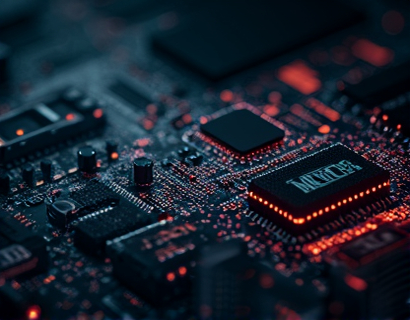Next-Gen Smart Contract AMMs: Revolutionizing DeFi Trading with Advanced Automation
In the rapidly evolving world of decentralized finance, or DeFi, the integration of smart contract-based Automated Market Makers (AMMs) is transforming the way crypto traders interact with markets. These advanced systems leverage the power of blockchain technology to provide a more efficient, transparent, and automated trading experience. This article delves into the intricacies of next-generation smart contract AMMs, exploring how they optimize liquidity management and automate trading strategies, ultimately elevating the DeFi trading landscape.
Understanding Smart Contract AMMs
Traditional AMMs rely on algorithms to determine asset prices and manage liquidity pools, eliminating the need for order books and centralized exchanges. Smart contract AMMs take this concept a step further by utilizing blockchain's inherent transparency and immutability. These contracts are self-executing and automatically enforce the terms of the trading agreements, ensuring trustless and decentralized market operations.
The core mechanism of a smart contract AMM involves liquidity pools, where users deposit pairs of cryptocurrencies to facilitate trading. These pools are managed by smart contracts that calculate the exchange rates based on the current supply and demand within the pool. This approach reduces the risk of front-running and slippage, common issues in traditional trading platforms.
Advanced Automation in AMMs
One of the most significant advancements in smart contract AMMs is the integration of sophisticated automation features. These systems employ complex algorithms and machine learning techniques to optimize trading strategies, adapt to market conditions, and manage liquidity more effectively. Automated rebalancing, for instance, ensures that liquidity pools maintain optimal depth and liquidity, enhancing the trading experience for all participants.
Another key feature is the implementation of adaptive pricing models. These models adjust to market volatility and liquidity levels, providing more accurate and fair pricing. By continuously monitoring market data, smart contract AMMs can respond in real-time to changes, ensuring that traders always have access to the most current and relevant information.
Optimizing Liquidity Management
Liquidity management is a critical aspect of DeFi trading, and smart contract AMMs offer innovative solutions to enhance this process. One such solution is the use of dynamic fee structures. These fees adjust based on the current liquidity levels and market conditions, incentivizing users to provide liquidity when it's most needed. This dynamic approach not only improves the efficiency of liquidity pools but also ensures that liquidity providers are fairly compensated.
Moreover, smart contract AMMs facilitate cross-chain liquidity, allowing assets to be traded across different blockchain networks seamlessly. This interoperability is achieved through the use of decentralized bridges and atomic swaps, which are managed by smart contracts. By breaking down silos between different DeFi ecosystems, these systems create a more unified and liquid global market.
Enhancing Trading Strategies with Automation
Automated trading strategies, or bots, have long been a staple in traditional finance, but their integration into DeFi through smart contract AMMs brings a new level of sophistication. These bots can execute complex trading algorithms, such as arbitrage, mean reversion, and momentum trading, without human intervention. This automation not only increases trading efficiency but also reduces emotional biases that can lead to suboptimal decisions.
Smart contract AMMs support the deployment of customizable trading bots, allowing users to tailor strategies to their specific needs and risk tolerances. These bots can be programmed to monitor multiple markets simultaneously, execute trades at optimal times, and adjust strategies based on real-time data. This level of automation empowers traders to focus on higher-level decision-making while leaving the execution to the smart contracts.
Security and Trust in Smart Contract AMMs
Security is paramount in the DeFi space, and smart contract AMMs are designed with robust security measures to protect user assets. The use of open-source code allows for community scrutiny, enabling developers to identify and fix vulnerabilities proactively. Additionally, formal verification techniques are employed to mathematically prove the correctness of smart contract logic, further enhancing trust in these systems.
Another critical aspect of security is the implementation of multi-signature wallets and decentralized governance models. These features ensure that critical operations, such as upgrades and fund transfers, require consensus from multiple parties, reducing the risk of unauthorized access or manipulation.
User Experience and Accessibility
Despite their complexity, smart contract AMMs are designed to provide an intuitive and user-friendly experience. Through user-friendly interfaces and comprehensive documentation, these platforms make advanced trading tools accessible to both seasoned crypto professionals and newcomers to the space. This democratization of access ensures that a broader audience can benefit from the efficiencies and opportunities offered by DeFi trading.
Furthermore, the integration of educational resources and community support helps users understand the intricacies of smart contract AMMs. Tutorials, webinars, and forums provide valuable insights and guidance, fostering a knowledgeable and engaged user base.
Future Prospects and Challenges
The future of smart contract AMMs in DeFi is promising, with ongoing developments aimed at addressing current challenges and expanding functionality. One area of focus is scalability, as the adoption of DeFi grows, the need for faster and more cost-effective transactions becomes increasingly important. Layer 2 solutions and optimized smart contract designs are being explored to address these issues.
Another frontier is the integration of advanced analytics and AI-driven insights. By leveraging big data and machine learning, smart contract AMMs can provide deeper market insights, predictive analytics, and personalized trading recommendations. This enhanced intelligence will further empower traders to make informed decisions and optimize their strategies.
However, challenges remain, including regulatory uncertainty and the need for broader institutional adoption. As the DeFi ecosystem matures, collaboration between regulators and the DeFi community will be crucial in establishing clear guidelines and frameworks. Additionally, gaining the trust of traditional financial institutions will require demonstrating the reliability and stability of smart contract AMMs.
Conclusion
Next-generation smart contract AMMs are revolutionizing DeFi trading by offering advanced automation, optimized liquidity management, and enhanced user experiences. These systems not only streamline trading operations but also open up new possibilities for innovative trading strategies and cross-chain interactions. As the technology continues to evolve, smart contract AMMs will play a pivotal role in shaping the future of decentralized finance, providing a more efficient, secure, and accessible trading environment for all participants.











































